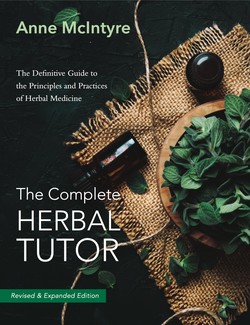Читать книгу The Complete Herbal Tutor - Anne Mcintyre - Страница 30
На сайте Литреса книга снята с продажи.
ОглавлениеFormulating a Herbal Prescription
Herbal prescriptions are generally tailor-made for each individual, depending on their specific needs. They need to address a variety of different issues. Digestion and elimination are absolutely central to good health and poor digestion, as dysbiosis and toxicity are underlying factors in a whole range of different illness including gut problems, lowered immunity, allergies, auto-immune disease, obesity and cancer.
Herbs to improve digestion and clear toxicity from the gut are therefore the first consideration. Then there are herbs that can be added for the constitutional imbalance and the system of the body affected, whether it is the nervous system in the case of anxiety and insomnia or the respiratory system in the case of bronchitis. Finally, herbs need to be included that are specific to the actual symptoms or disease, like frankincense for arthritis and uva ursi for urinary tract infections.
In short, the following factors need to be addressed when formulating a prescription:
• digestion
• toxicity
• constitution
• system involved
• disease
In the above instance of chronic ear infection, antimicrobial herbs like garlic, turmeric, ginger, golden seal, neem and cinnamon could be given to combat infection and dysbiosis. Those chosen could be combined with immune-enhancing herbs such as andrographis, thyme, echinacea, and pau d'arco. Decongestant herbs like peppermint, elderflowers, yarrow and ginger can be given in teas (as hot infusions work better than tinctures) to clear excess mucous. Diluted essential oils of lavender, chamomile or thyme can be used in ear drops or used for massage around the ear and throat to relieve congestion in the eustachian tube.
Many ask how long it will take to recover, and of course this depends very much on the nature of the illness and how long the symptoms have been apparent, as well as on the age, constitution, vitality and strength of the patient. A person treated with herbs may not necessarily “recover” as quickly as one treated with conventional allopathic drugs, but once better the patient will feel stronger than after a course of orthodox medicine. By increasing general health and the efficiency of weak organs or body systems, herbal medicine helps raise resistance to further illness and prevents chronic disease.
Prescribing Herbal Medicines
The method of administering herbs and the length of treatment needed by a patient will vary considerably according to the condition being treated, which herbs are used, their age, build and constitution, and even the time of year.
The dosage of herbs chosen for the prescription needs to be carefully determined.
The dosage, the herbs chosen for the prescription, and the timing of administration all need to be determined. A largely built person with big bones and muscles, and a comparatively sluggish metabolism, will generally require herbs to be given in larger doses and over a longer period of time than a small framed, lightweight person with a more sensitive body and faster metabolism.
Dosage for adult patients can also vary according to the practitioner and which kind of herbal medicines they practice. A standard dose of tincture can vary from a few drops to 5mls (one teaspoon). Teas are generally taken a cupful at a time, powders are taken in doses of ¼–1 tsp and syrups may require being taken a dessertspoon or tablespoon at a time.
Chronic and Acute Conditions
When treating chronic conditions, generally mild herbal remedies are taken three times daily, over months at a time if necessary. It may be that the first prescription and dietary advice is intended to improve digestion and absorption and to clear toxins from the system, which is necessary in so many cases. This will be followed up by more nourishing tonic medicines until the patient is better. Acute conditions may require stronger herbs given up to every two hours. To illustrate, ashwagandha is nourishing and strengthening and is taken often 2–3 times a day over a few weeks or months to improve energy, vitality, immunity and enhance resilience to stress. Echinacea and wild indigo are taken every 2 hours to enhance immunity and combat acute infections.
Appropriate Administration
Hot preparations are needed when treating fevers, colds, catarrh and problems associated with cold, such as poor circulation and menstrual cramps. Others problems such as urinary problems and conditions associated with heat, such as hot flushes and acne, are better suited to cool preparations. Skin problems may improve more rapidly using herbal teas as opposed to tinctures, while tinctures may be preferable when more concentrated medicines are needed, as when treating a virulent infection.
The herbs chosen may also indicate their best method of administration. When giving teas, the aerial parts of a plant are prepared as infusions while roots, barks and seeds are better suited to decoctions. Nourishing tonics are best taken as powders stirred into warm milk or water, while warming spices to clear catarrhal congestion and coughs can be taken as powders mixed with honey and taken off a spoon.
Generally, herbs are taken either side of or during a meal. When using herbs to enhance appetite, digestion and absorption, they can be taken before a meal; for problems associated with heat, acidity and inflammation they can be taken with a meal, otherwise they can be taken immediately after eating. Tinctures need to be diluted with water, otherwise they can be unpleasant tasting and can irritate a delicate stomach.
CHILD'S DOSAGE GUIDELINES
When it comes to dosage for children, there are two rules that are employed by some practitioners:
Young's method: child's dosage = adult dose (generally 5mls) x age divided by the age +12.
Cowling's method: child's dosage = adult dose x age divided by 24.
Alternatively, dosage can be calculated according to weight: child's dosage = adult dose x child's weight divided by 68 kg (150 lbs).
